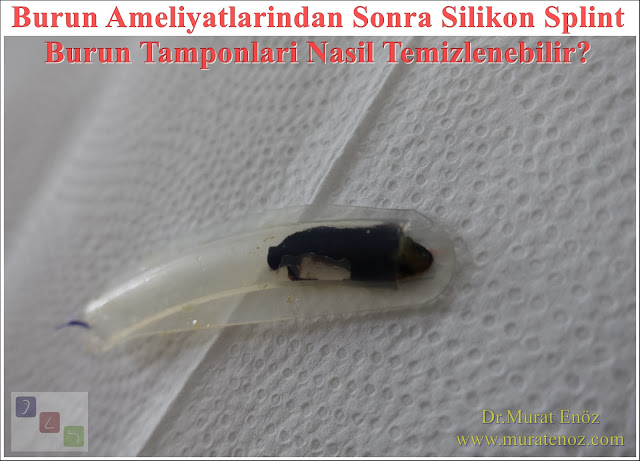Postoperative Care For Internal Nasal Splints
Internal Nasal Splints are nasal tampons that are placed after the nasal surgery and have a breathing hole that allows the patient to breathe. They cause less pain than other nasal packings since they do not adhere to the hair or mucosa in the nose during removal. Intranasal nasal silicone splint is known as an intramedullary cylindrical air canal that allows the patient to breathe through the nose. They prevent the formation of adhesions in the nose.
How to Clean Internal Nasal Splint?
What I write here is usually the ones I recommend to my patients. Different clinical and physician may have different recommendations. Please pay attention to the recommendations of the clinic you are operating in for the use of medicines and intranasal care products after surgery. Silicone splints in the nose are usually removed 5-10 days after the nasal surgery. To keep the air duct inside these silicones clean, you can take a look at the following suggestions:
• Drops - spray - drops into the nose at least 4 times a day in the form of new and nasal congestion of the nose can be applied spray and drip between them can be done: Tilt your head backwards and each nostril moisturizing nose drops 2-3 drops of the moisturizer. When you feel the taste of the droplet, get up and go to the sink and tilt your head forward to the east and squeeze the pressurized ocean water into each nostril. Continue spraying the sprayer until you feel that the water is coming back through each nostril. Wait a few minutes, and then tilt your head back and drop the oily moisturizing nose drop in each nostril
• After the application of drops - spray - drops into the nose, blood clots may cause the hole in the silicone to clog. If you feel that there is no air coming through the hole in these applications, you can turn on the lamp light of your mobile phone and insert the end of the spray cover into the hole of the silicone, and i can squeeze the head forward and spray, while you can draw your breath away from the nose. You can then slowly send the air in the form of exhalation through the nose.
• The silicone splints are clogged most back side, as seen in the photos. If the silicone buffers are not cleaned at all, the nose may become fully occluded, and the patient may develop symptoms such as dry throat, night throat pain, ears of ears while hearing pressure, pressure sensation and obstruction.
• silicone nasal tampons may cause influenza or flu-like nasal discharge with a foreign body reaction in the nose. It is not necessary to use a special medication for this nasal discharge after the fifth day after the operation. The more moist the inside of the nose is, the better the rate of nasal mucosa recovery. However, it may be necessary to use allergy pills if silicone splints cause sneezing attacks.
Is It Possible To Breathe Through The Nose After Being Placed Internal Nasal Splints?
If the inside of the silicone splints is cleaned regularly by spraying the ocean water sprays, the round channel, which normally allows the patient to breathe through the nose, is not clogged with the clot and the patient can breathe through the nose.
How to Remove Internal Nasal Splint
Internal nasal silicone splints are fixed to the anterior part of the nasal septum, usually with one suture. After the suture has been cut, it is removed in office conditions as seen in the video below. It causes much less pain than classic nasal tampons.
Internal Nasal Splint Removal Video:
Murat Enoz, MD, Otorhinolaryngology, Head and Neck Surgeon - ENT Doctor in Istanbul
Private Office:
Address: İncirli Cad. No:41, Kat:4 (Dilek Patisserie Building), Postal code: 34147, Bakırköy - İstanbul
Appointment Phone: +90 212 561 00 52
Appointment Phone: +90 212 561 00 52
Fax: +90 212 542 74 47







Comments
Post a Comment